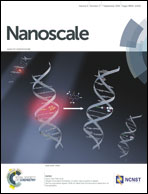Long-range chemical orders in Au–Pd nanoparticles revealed by aberration-corrected electron microscopy†
Abstract
Despite the importance of gold–palladium nanoalloys in heterogeneous catalysis, the phase stability of Au–Pd alloys still remains unclear. We report here on the alloying and chemical ordering in epitaxially-grown and post-annealed gold–palladium nanoparticles (NPs) using aberration-corrected transmission electron microscopy. Au–Pd NPs with a controlled size, composition and structure were grown by pulsed laser deposition on freshly-cleaved NaCl(001) single crystals heated at 300 °C. After transfer to an amorphous carbon support, the NPs were annealed in vacuum at elevated temperatures above 400 °C for a few hours (6–10 hours) to promote chemical ordering. The as-grown NPs were mostly monocrystalline with a chemically-disordered face-centered cubic structure. Upon high-temperature annealing, a high degree of chemical ordering was observed in nanometer-sized NPs. Electron microscopy measurements showed that both L10 and L12 orders are stabilized in the Au-rich region of the Au–Pd phase diagram. These ordered phases exist at temperatures as high as 600 °C. Moreover, compositional analysis of single annealed particles revealed that the observed chemical ordering occurs in parallel to a two-tiered Ostwald ripening process. Due to this ripening process, a clear dependence between chemical composition and particle size is established during annealing with an enrichment in Pd as the NPs grow in size. Our results, besides clarifying some controversial aspects about long-range order in Au–Pd alloys, shed light on the structural stability of Au–Pd nanoalloys at elevated temperatures.


 Please wait while we load your content...
Please wait while we load your content...